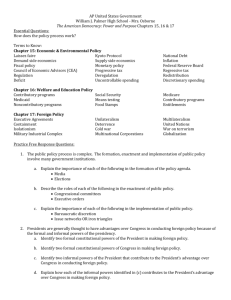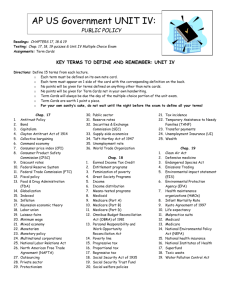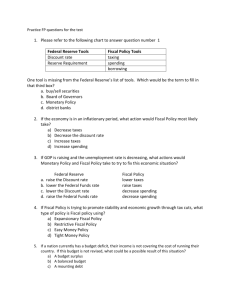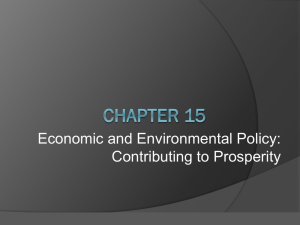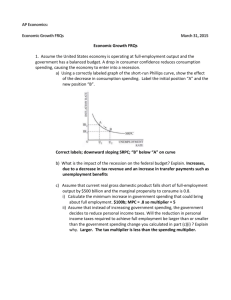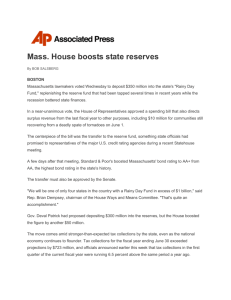Unit V- Public Policy I) Entitlement spending is the largest portion of
advertisement
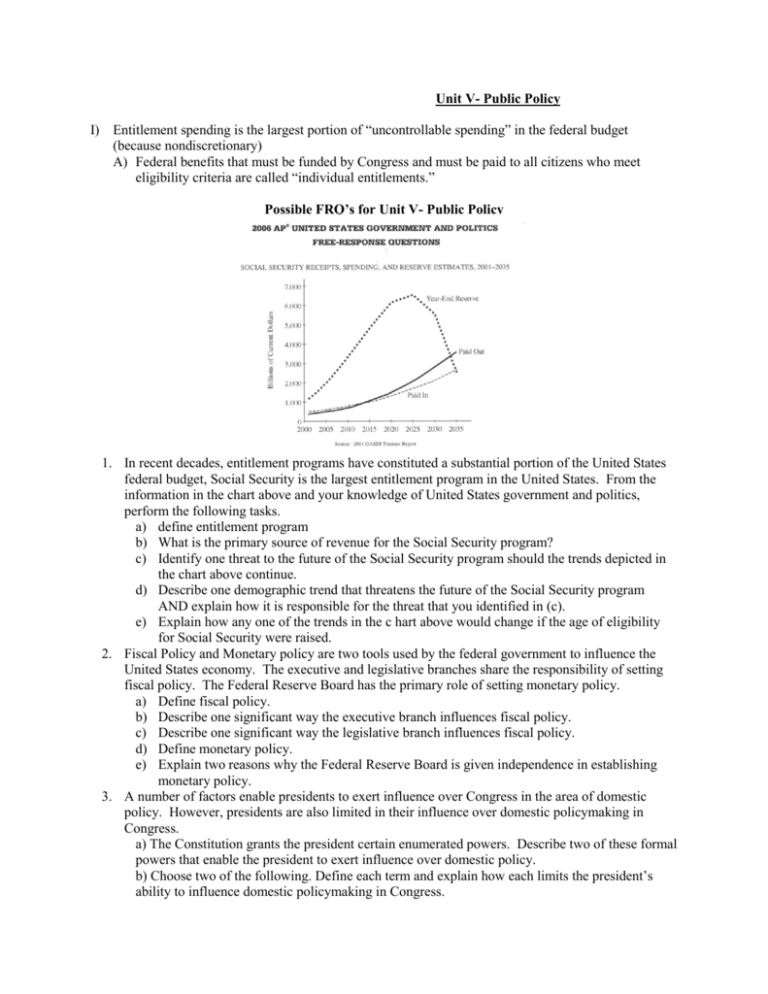
Unit V- Public Policy I) Entitlement spending is the largest portion of “uncontrollable spending” in the federal budget (because nondiscretionary) A) Federal benefits that must be funded by Congress and must be paid to all citizens who meet eligibility criteria are called “individual entitlements.” Possible FRQ’s for Unit V- Public Policy 1. In recent decades, entitlement programs have constituted a substantial portion of the United States federal budget, Social Security is the largest entitlement program in the United States. From the information in the chart above and your knowledge of United States government and politics, perform the following tasks. a) define entitlement program b) What is the primary source of revenue for the Social Security program? c) Identify one threat to the future of the Social Security program should the trends depicted in the chart above continue. d) Describe one demographic trend that threatens the future of the Social Security program AND explain how it is responsible for the threat that you identified in (c). e) Explain how any one of the trends in the c hart above would change if the age of eligibility for Social Security were raised. 2. Fiscal Policy and Monetary policy are two tools used by the federal government to influence the United States economy. The executive and legislative branches share the responsibility of setting fiscal policy. The Federal Reserve Board has the primary role of setting monetary policy. a) Define fiscal policy. b) Describe one significant way the executive branch influences fiscal policy. c) Describe one significant way the legislative branch influences fiscal policy. d) Define monetary policy. e) Explain two reasons why the Federal Reserve Board is given independence in establishing monetary policy. 3. A number of factors enable presidents to exert influence over Congress in the area of domestic policy. However, presidents are also limited in their influence over domestic policymaking in Congress. a) The Constitution grants the president certain enumerated powers. Describe two of these formal powers that enable the president to exert influence over domestic policy. b) Choose two of the following. Define each term and explain how each limits the president’s ability to influence domestic policymaking in Congress. Mandatory spending Party polarization Lame-duck period 4. Using the information in the figure above and your knowledge of United States policies, complete the following tasks. a) Describe what the figure above demonstrates about the distribution of government benefits over time. b) Identify two politically relevant factors that have affected the changing distribution of government benefits between children and the elderly. c) Explain how each of the two factors identified in (b) has affected the changing distribution of government benefits Principles of Released MC’s and FRQ’s (Unit V- Public Policy) The activities of the Federal Reserve board have the most direct influence on bank interest rates The Office of Management and Budget is responsible for the preparation of executive spending proposals submitted to Congress. The best predictor of a department’s annual budget (like the department of Education)is the size of the previous year’s budget. Independent regulatory commissions are created primarily for the purpose of regulating industries to protect the public’s interest. Diversity of public policy throughout the United States is primarily a consequence of federalism. Fiscal policy is taxing and/or spending. The Executive Branch has control over fiscal policy through: The budget, The president proposes/prepares the federal budget, The president signs/vetoes legislation (related to taxing, spending, and borrowing, not generic), The White House Office of Management and Budget (OMB) recommend the budget. The Legislative Branch has control over fiscal policy through: Congress passes the federal budget, Congress acts on tax and spending legislation, The Congressional Budget Office (CBO) advises Congress on Economic policies. Monetary policy is: Regulating the money supply, Controlling inflation/deflation, Adjusting interest rates to regulate the economy, Adjusting bank reserve requirements, The cost of money, The Federal Reserve is given independence in decision-making because: It removes politics from monetary policy decision making, Congress/the president can abdicate responsibility for difficult decisions by delegating decision-making power, The Federal Reserve Board relies on expertise when making decisions, The Federal Reserve Board makes economic policies efficiently. Entitlement programs are government-sponsored programs providing mandated/guaranteed/required benefits to those who meet eligibility requirements/qualifications The primary source of revenue for Social Security is: Payroll taxes, Wages from existing wage earners, Tax based on earned income, Targeted/earmarked taxes Threats to the future of the Social Security program include: Run out of money, Outputs exceed inputs, Declining reserve. Demographic trends affecting Social Security: More older people/”baby boom” generation, People living longer/greater life expectancy, Declining birth rates Who is responsible for these threats? The number of workers who fund Social Security is decreasing, but the number of people eligible for Social Security is increasing, The number of working people cannot support the large population who will soon reach the age of eligibility to receive Social Security, The ratio of workers to retirees is becoming more unequal. With fewer workers, less money is being paid in, and with more retirees, more money is being paid out. The trends would change if the age of eligibility for Social Security were raised because if people were to work longer, less money would be paid out/more money would be paid in/the reserve would not decline as rapidly or as much.

